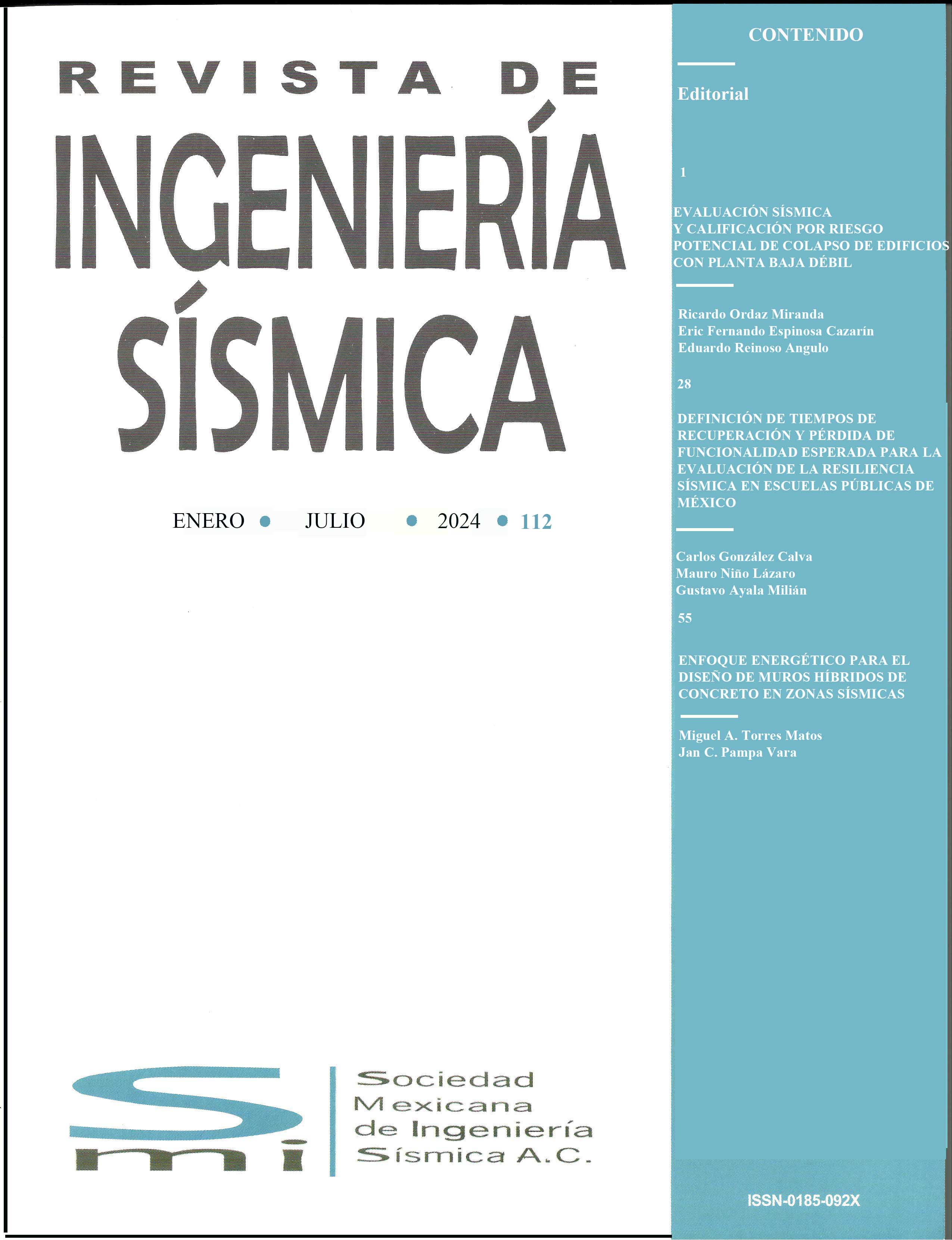BEHAVIOR OF STEEL BUILDINGS WITH ECCENTRICALLY BRACED FRAMES SUBJECTED TO SEISMIC SEQUENCES
DOI:
https://doi.org/10.18867/ris.100.486Abstract
This paper presents the results of an analytical study focused on evaluating the seismic behavior of steel buildings having eccentric braced frames (EBFs) as structural system. For this purpose, two 4-story and 8-story EBFs were modeled using the computational platform OpenSees. Particularly, modelling strategy included the hysteretic behavior of the links in the eccentric braces taking into account a failure criterion as well as the panel zone in the beam-column joints. The case-study EBFs were subjected to a set of artificial mainshock-aftershock seismic sequences, which are representative of those recorded in soft soil sites of Mexico City. The results of this investigation reveal that the links can fail under strong aftershocks, which lead to an increment in the maximum interstory drifts with respect to those from the mainshock. In this situation, it was observed that the beams and columns near the link that failed can exhibit nonlinear behavior, which is opposite to its design philosophy. Finally, it was also noted that the EBFs tends to concentrate the maximum interstory drifts at the bottom stories since the links do not exhibit a uniform hysteretic behavior along height, which does not take fully advantaje of the energy dissipation capacity of the links.Downloads
References
AISC (2002) Seismic provisions for structural steel buildings, ANSI/AISC 341-02, American Institute of Steel Construction, Chicago, Illinois, 309 pp.
AISC (2016) Seismic provisions for structural steel buildings, ANSI/AISC 341-16, American Institute of Steel Construction, Chicago, Illinois, 309 pp.
ASCE (1990) Minimum design loads for buildings and other structures, ASCE 7-88, American Society of Civil Engineers, New York, New York, 94 pp.
Azad, S K y C Topkaya (2017), “A review of research on steel eccentrically braced frames”, Journal of Constructional Steel Research, Vol. 128, pp. 53–73. DOI: 10.1016/j.jcsr.2016.07.032
Díaz, M A (2006), “Confiabilidad sísmica de edificios de acero diseñados con el RCDF-2004”, Tesis de Maestría, Facultad de Ingeniería, Universidad Nacional Autónoma de México, 69 pp.
Díaz-Martínez, G, J Ruiz-García y A Terán-Gilmore (2014), “Response of structures to seismic sequences corresponding to Mexican soft soils”, Earthquakes and Structures, Vol. 7, pp. 1241-1258. DOI: 10.12989/eas.2014.7.6.1241
Guerrero, H, J Ruiz-García, J A Escobar y A Terán-Gilmore (2017), “Response to seismic sequences of short-period structures equipped with buckling-restrained braces located on the lakebed zone of Mexico City”, Journal of Constructional Steel Research, Vol. 137, pp. 37–51. DOI: 10.1016/j.jcsr.2017.06.010
Gulec, C K, B Gibbons, A Chen y A S Whittaker (2011), “Damage states and fragility functions for link beams in eccentrically braced frames”, Journal of Constructional Steel Research, Vol. 67, No. 9, pp. 1299-1309. DOI: 10.1016/j.jcsr.2011.03.014
Gupta, A y H Krawinkler (1999), "Seismic demands for performance evaluation of steel moment resisting frame structures," Technical Report 132, The John A. Blume Earthquake Engineering Research Center, Department of Civil Engineering, Stanford University, Stanford, CA.
Kanvinde, A M, K S Marshall, D A Grilli y G Bomba (2014), “Forensic analysis of link fractures in eccentrically braced frames during the February 2011 Christchurch Earthquake – Testing and Simulation”, Journal of Structural Engineering ASCE, 141(5). DOI: 10.1061/(ASCE)ST.1943-541X.0001043
McKenna, F, G L Fenves, M H Scott y B Jeremic (2000), Open system for earthquake engineering simulation (OpenSees). Pacific Earthquake Engineering Research Center, University of California, Berkeley.
Meli, R y J A Avila (1989), “The Mexico earthquake of September 19, 1985—Analysis of building response”, Earthquake Spectra, Vol. 5, No. 1, pp. 1–18. DOI: 10.1193/1.1585506
Miranda, E (1993), “Evaluation of site-dependent inelastic seismic design spectra”, Journal of Structural Engineering, ASCE, 119(5): pp. 1319-1338. DOI: 10.1061/(ASCE)0733-9445(1993)119:5(1319)
NTC-A (2004), “Normas técnicas complementarias para el diseño y construcción de estructuras de acero”, Gaceta Oficial del Gobierno del Distrito Federal, agosto.
NTC-A (2017), “Normas técnicas complementarias para el diseño y construcción de estructuras de acero”, Gaceta Oficial del Gobierno de la Ciudad de México, diciembre.
Okazaki, T, G Arce, H-C Ryu y M D Engelhardt (2005), "Experimental study of local buckling, overstrength, and fracture of links in eccentrically braced frames”, Journal of Structural Engineering, 131(10), pp. 1526-35. DOI: 10.1061/(ASCE)0733-9445(2005)131:10(1526)
Prinz, G S (2010), “Using buckling-restrained braces in eccentric configurations”, PhD. Dissertation, Brigham Young University. https://scholarsarchive.byu.edu/etd/2134
Ramadan, T y A Ghobarah (1995), “Analytical model for shear-link behavior”, Journal of Structural Engineering, ASCE, Vol. 121, No.11, pp. 1574-1580. DOI: 10.1061/(ASCE)0733-9445(1995)121:11(1574)
Richards, P W (2004), "Cyclic stability and capacity design of steel eccentrically braced frames" Ph.D. dissertation, Dept. of Structural Engineering, Univ. of California, San Diego, La Jolla, CA.
Rosenblueth, E y R Meli, (1986), “The 1985 Mexico earthquake: causes and effects in Mexico City”, Concrete International, ACI, Vol. 8, No. 5, pp. 23-34.
Ruiz-García J (2012), “Mainshock-aftershock ground motion features and their influence in building’s seismic response”, Journal of Earthquake Engineering, Vol. 16, No. 5, pp. 719-737. DOI: 10.1080/13632469.2012.663154
Ruiz-García J, M V Marín y A Terán-Gilmore (2014), “Effect of seismic sequences in reinforced concrete frame buildings located in soft-soil sites”, Soil Dynamics and Earthquake Engineering, Vol. 63, pp. 56-68. DOI: 10.1016/j.soildyn.2014.03.008
Tapia, E y A Tena (2011), “Factores de ductilidad y sobrerresistencia en marcos de acero con contraventeo chevron”, Revista de Ingeniería Sísmica, Vol. 84, pp. 47-68. DOI: 10.18867/ris.84.25
Terán-Gilmore, A, A Sanchez-Badillo, M Espinosa-Johnson (2010), “Performance-based seismic design of reinforced concrete ductile buildings subjected to large energy demands”, Earthquakes and Structures; Vol. 1, No. 1, pp. 69-92. DOI: 10.12989/eas.2010.1.1.069
Vamvatsikos, D y C A Cornell (2002), “Incremental dynamic analysis”, Earthq Eng. Struct Dynam; Vol. 31, No. 3, pp. 491-514. DOI: 10.1002/eqe.141






